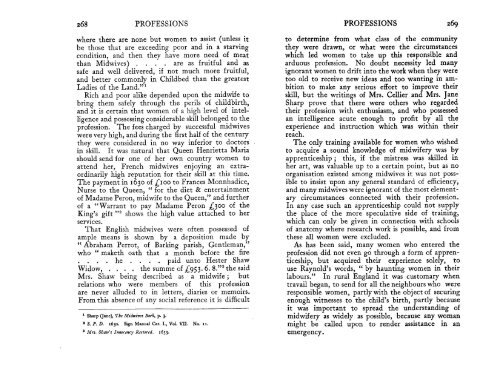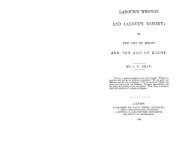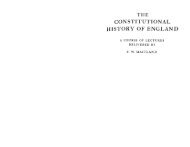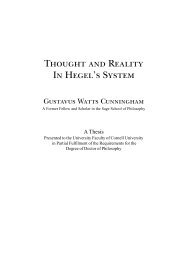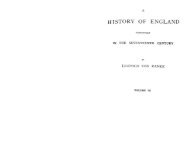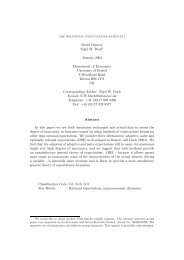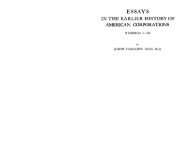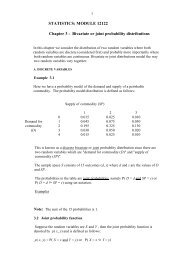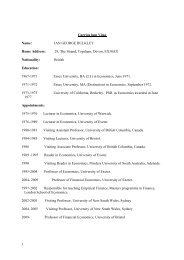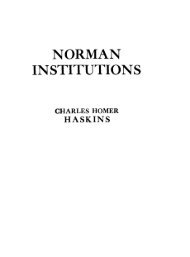268 PROFESSIONSwhere there are none but <strong>women</strong> to assist (unless itbe those that are exceeding poor and in a starvingcondition, and then they have more need <strong>of</strong> meatthan Midwives) . . .' . are as fruitful and assafe and well delivered, if not much more fruitful,and better commonlf. in Childbed than the greatestLadies <strong>of</strong> the Land."'Rich and poor alike depended upon the midwife tobring them safely through the perils <strong>of</strong> childbirth,and it is certain that <strong>women</strong> <strong>of</strong> a high level <strong>of</strong> intelligenceand possessing considerable skill belonged to thepr<strong>of</strong>ession. The fees charged by successful midwiveswere very high, and during the first half <strong>of</strong> the <strong>century</strong>they were considered in no way inferior to doctorsin skill. It was natural that Queen Henrietta Mariashould send for one <strong>of</strong> her own country <strong>women</strong> toattend her, French midwives enjoying an extra-ordinarily high reputation for their skill at this time.The payment in 1630 <strong>of</strong> LIOO to Frances Monnhadice,Nurse to the Queen, " for the diet & entertainment<strong>of</strong> Madame Peron, midwife to the Queen," and further<strong>of</strong> a "Warrant to pap Madame Peron L300 <strong>of</strong> theKing's gift "2 shows the high value attached to herservices.That English midwives were <strong>of</strong>ten possessed <strong>of</strong>ample means is shown by a deposition made by" Abraham Perrot, <strong>of</strong> Barking parish, Gentleman,"who " maketh oath that a month before the fire. . . . he . . . . paid unto Hester ShawWidow, . . . . the summe <strong>of</strong> L953.6. the saidMrs. Shaw being described as a midwife ; butrelations who were members <strong>of</strong> this pr<strong>of</strong>essionare never alluded to in letters, diaries or memoirs.From this absence <strong>of</strong> any social reference it is difficultSharp (Jane), Tbe Midwives Bwk, p. 3.P S. P. D. 1630. Sign Manual Car. I., Vol. VIl. No. 11.S Mrs. Sbaw's Zn~cency Restored. 1653.PROFESSIONSto determine from what class <strong>of</strong> the communitythey were drawn, or what were the circumstanceswhich led <strong>women</strong> to take up this responsible andarduous pr<strong>of</strong>ession. No doubt necessity led manyignorant <strong>women</strong> to drift into the work when they weretoo old to receive new ideas and too wanting in ambitionto make any serious effort to improve theirskill, but the writings <strong>of</strong> Mrs. Cellier and Mrs. JaneSharp prove that there were others who regardedtheir pr<strong>of</strong>ession with enthusiasm, and who possessedan intelligence acute enough to pr<strong>of</strong>it by all theexperience and instruction which was within theirreach.The only training available for <strong>women</strong> who wishedto acquire a sound knowledge <strong>of</strong> midwifery was byapprenticeship ; this, if the mistress was skilled inher art, was valuable up to a certain point, but as noorganisation existed among midwives it was not possibleto insist upon any general standard <strong>of</strong> efficiency,and many midwives were ignorant <strong>of</strong> the most elementarycircumstances connected with their pr<strong>of</strong>ession.In any case such an apprenticeship could not supplythe place <strong>of</strong> the more speculative side <strong>of</strong> training,which can only be given in connection with schools<strong>of</strong> anatomy where research work is possible, and fromthese all <strong>women</strong> were excluded.As has been said, many <strong>women</strong> who entered thepr<strong>of</strong>ession did not even go through a form <strong>of</strong> apprenticeship,but acquired their experience solely, touse Raynold's words, " by haunting <strong>women</strong> in theirlabours." In rural England it was customary whentravail began, to send for all the neighbours who wereresponsible <strong>women</strong>, partly with the object <strong>of</strong> securingenough witnesses to the child's birth, partly becauseit was important to spread the understanding <strong>of</strong>midwifery as widely as possibie, because any womanmight be called upon to render assistance in anemergency.
PROFESSIONS PROFESSIONS 271Several handbooks on Midwifery were written inresponse to the demand for opportunities for scientifictraining by the more intelligent members <strong>of</strong> the pr<strong>of</strong>ession.One <strong>of</strong> the most popular <strong>of</strong> these books,which passed through manv editions, was publishedin 1671 by Jane Sharp " Practitioner in the art <strong>of</strong>Midwifery above jo years." The preface to the fourthedition says that " the constant and unweariedIndustry <strong>of</strong> this ingenious and well-skill'd midwife,Mrs. Jane Sharp, together with her great Experience<strong>of</strong> Anatomy & Physick, by the many years <strong>of</strong> herPractice in the art <strong>of</strong> Midwifery hath . . . . .made them . . . . much desired by all thateither knew her Person . . . . or ever read thisbook, which <strong>of</strong> late, by its Scarceness hath been somuch enquired after . . . . as to have manyafter impressions." The author says that she has" <strong>of</strong>ten sate down sad in the Consideration <strong>of</strong> themany Miseries Women endure in the Hands <strong>of</strong> unskilfulMidwives ; many pr<strong>of</strong>essing the Art (withoutany skill in anatomy, which is the Principal parteffectually necessary for a Midwife) meerly for Lucressake.I have been at Great Cost in Translationsfor all Books, either French, Dutch or Italian <strong>of</strong> thiskind. All which I <strong>of</strong>fer with my own Experience.'"Jane Sharp points out that midwives must be bothspeculative and practical, for " she that wants theknowledge <strong>of</strong> Speculation, is like one that is blindor wants her sight : she that wants the Practice, islike one that is lame & wants her legs, . . . . .Some perhaps may think, that then it is not properfor <strong>women</strong> to be <strong>of</strong> this pr<strong>of</strong>ession, because they cannotattain so rarely to the knowledge <strong>of</strong> things as men may,who are bred up in Universities, <strong>School</strong>s <strong>of</strong> Learning,or serve their Apprenticeship for that end and purpose,,where anatomy Lectures being frequently read theU*Sharp, Mm. Jane,ducovmcd.7be Midwives BOOR, or tbe dole Art <strong>of</strong> Mzdwzfsysituation <strong>of</strong> the parts both <strong>of</strong> men and <strong>women</strong> . . .are <strong>of</strong>ten made plain to them.But that objection iseasily answered, by the former example <strong>of</strong> the Midwivesamongst the Israelites, for, though we <strong>women</strong>cannot deny that men in some things may come to agreater perfection <strong>of</strong> knowledge than <strong>women</strong> ordinarilycan, by reason <strong>of</strong> the former helps that <strong>women</strong>want ; yet the Holy Scriptures hath recorded Midwivesto the perpetual honour <strong>of</strong> the female Sex.There not being so much as one word concerning menmidwives mentioned there . . . . it being thenatural propriety <strong>of</strong> <strong>women</strong> to be much seeing intothat art ; and though nature be not alone sufficientto the perfection <strong>of</strong> it, yet further knowledge may begain'd by a long and diligent practice, and he communicatedto others <strong>of</strong> our own sex. I cannot denythe honour due to able Physicians and Chyrurgions,when occasion is, Yet . . . . where there isno Men <strong>of</strong> Learning, the <strong>women</strong> are sufficient toperform this duty . . . . It is not hard wordsthat perform the work, as if none understood the Artthat cannot understand Greek. Words are butthe shell, that we <strong>of</strong>times break our Teeth with themto come at the kernel, I mean our brains to know whatis the meaning <strong>of</strong> them ; but to have the same in ourmother tongue would save us a great deal <strong>of</strong> needlesslabour. It is commendable for men to employ theirspare time in some things <strong>of</strong> deeper Speculation thanis required <strong>of</strong> the female sex ; but the art <strong>of</strong> Midwifery chiefly concerns us."'Though the schools <strong>of</strong> Medicine and Anatomy wereclosed to <strong>women</strong>, individual doctors were willing toteach the more progressive midwives some <strong>of</strong> thescience necessary for their art ; thus Culpeperdedicated his " Directory " to the midwives <strong>of</strong> Englandin the following words :-" Worthv Matrons, You are <strong>of</strong>' S*Mn. Jane .7bc Midroivcr Book, pp. 1-q.
- Page 1 and 2:
WORKING LIFE OF WOMENIN THESEVENTEE
- Page 6 and 7:
4 INTRODUCTORYtragic class of wage
- Page 8 and 9:
8 INTRODUCTORY INTRODUCTORYDomestic
- Page 10 and 11:
INTRODUCTORYunmarried girls go out
- Page 12 and 13:
I 6 CAPITALISTS CAPITALISTS" I loos
- Page 14 and 15:
CAPITALISTSweak woman stands in the
- Page 16 and 17:
24 CAPITALISTS CAPITALISTS 25wife t
- Page 18 and 19:
2 8 CAPITALISTS CAPITALISTS 29Majes
- Page 20 and 21:
32 CAPITALISTSA warrant was issued"
- Page 22 and 23:
CAPITALISTSbusiness. " At O~tend, N
- Page 24 and 25:
CAPITALISTS CAPITALISTS41thro' her
- Page 26 and 27:
AGRICULTUREwas made of their develo
- Page 28 and 29:
AGRICULTUREis not drye as it should
- Page 30 and 31:
52 AGRICULTURE AGRICULTUREhave of h
- Page 32 and 33:
56 AGRICULTUREfor colonists in Virg
- Page 34 and 35:
AGRICULTUREmaintain completely the
- Page 36 and 37:
64 AGRICULTUREtime was well spent i
- Page 38 and 39:
AGRICULTUREExcept in exeptional cir
- Page 40 and 41:
72 AGRICULTURE AGRICULTURE 73mainta
- Page 42 and 43:
76 AGRICULTUREfor the impotent poor
- Page 44 and 45:
AGRICULTUREwhich we can imagine tha
- Page 46 and 47:
AGRICULTURE AGRICULTURE 85by his se
- Page 48 and 49:
AGRICULTUREher work, but generosity
- Page 50 and 51:
AGRICULTUREwife of Thos. Lyne. Toba
- Page 52 and 53:
TEXTILESwas paid better than the la
- Page 54 and 55:
TEXTILESroof provided them with the
- Page 56 and 57:
104 TEXTILESformulated by 25 Charle
- Page 58 and 59:
108 TEXTILES TEXTILES 109until the
- Page 60 and 61:
TEXTILESon spinning for their livin
- Page 62 and 63:
TEXTILESstill and dry within Doors,
- Page 64 and 65:
120 TEXTILES TEXTILESthe cloth made
- Page 66 and 67:
124TEXTILES TEXTILESin the closely
- Page 68 and 69:
TEXTILESKingdom, it required a grea
- Page 70 and 71:
132 TEXTILES TEXTILESnot exceedl6 1
- Page 72 and 73:
TEXTILES TEXTILES I37hours in four
- Page 74 and 75:
---P-I 4OTEXTILEScan be quoted of t
- Page 76 and 77:
'44 TEXTILES TEXTILESWood Streate,
- Page 78 and 79:
TEXTILEShigher wages than would hav
- Page 80 and 81:
1 52 CRAFTS AND TRADESdebts. For ex
- Page 82 and 83:
I 56 CRAFTS AND TRADES CRAFTS AND T
- Page 84 and 85:
160 CRAFTS AND TRADES CRAFTS AND TR
- Page 86 and 87:
164 CRAFTS AND TRADESAmong thirty-n
- Page 88 and 89: CRAFTS AND TRADESalso met with as b
- Page 90 and 91: 172 CRAFTS AND TRADES CRAFTS AND TR
- Page 92 and 93: 176 CRAFTS AND TRADESto Henry Joyce
- Page 94 and 95: 180 CRAFTS AND TRADES CRAFTS AND TR
- Page 96: CRAFTS AND TRADESWardens and Brothe
- Page 99 and 100: P-I9OCRAFTS AND TRADESmarriage ; it
- Page 101 and 102: CRAFTS AND TRADEStaken our goods fr
- Page 103 and 104: 1g8CRAFTS AND TRADESresources turne
- Page 105 and 106: CRAFTS AND TRADESThere were fewer r
- Page 107 and 108: 206 CRAFTS AND TRADES CRAFTS AND TR
- Page 109 and 110: CRAFTS AND TRADESA large proportion
- Page 111 and 112: 214CRAFTS AND TRADES CRAFTS AND TRA
- Page 113 and 114: 218 CRAFTS AND TRADES CRAFTS AND TR
- Page 115 and 116: 222 CRAFTS AND TRADES CRAFTS AND TR
- Page 117: CRAFTS AND TRADES CRAFTS AND TRADES
- Page 120 and 121: CRAFTS AND TRADESfrom her fellow pa
- Page 122 and 123: PROFESSIONS 237PROFESSIONSIntroduct
- Page 124 and 125: 24O PROFESSIONS PROFESSIONStheir Th
- Page 126 and 127: 244 PROFESSIONS PROFESSIONS 245the
- Page 128 and 129: PROFESSIONS PROFESSIONS 249profanat
- Page 130 and 131: 252PROFESSIONSGiles Moore enters in
- Page 132 and 133: PROFESSIONScribed as one who " dist
- Page 134 and 135: PROFESSIONS PROFESSIONS 261first ma
- Page 136 and 137: 264 PROFESSIONSGarrett's leg shall
- Page 140 and 141: PROFESSIONS PROFESSIONS 273the numb
- Page 142 and 143: PROFESSIONSexaminations, before six
- Page 144 and 145: PROFESSIONS PROFESSIONS 281death me
- Page 146 and 147: 284 PROFESSIONS PROFESSIONSof confi
- Page 148 and 149: 288 PROFESSIONSextent they were whe
- Page 150 and 151: CONCLUSIONor in her other facilitie
- Page 152 and 153: CONCLUSION CONCLUSION 297in women's
- Page 154 and 155: CONCLUSIONlaw of Nature, inviolable
- Page 156 and 157: CONCLUSIONwere specially deprecated
- Page 158 and 159: 308 CONCLUSIONof the State, and the
- Page 160 and 161: 312 AUTHORITIES AUTHORITIES 313Cost
- Page 162 and 163: AUTHORITIESMartindale, Adam, The Li
- Page 164 and 165: County.Buckingham ..Cardigan .. ..C
- Page 166 and 167: INDEXINDEXFlax, 64, 146, 246, 291 ;
- Page 168: INDEXsmants, women( 50,65,157 ; mam


